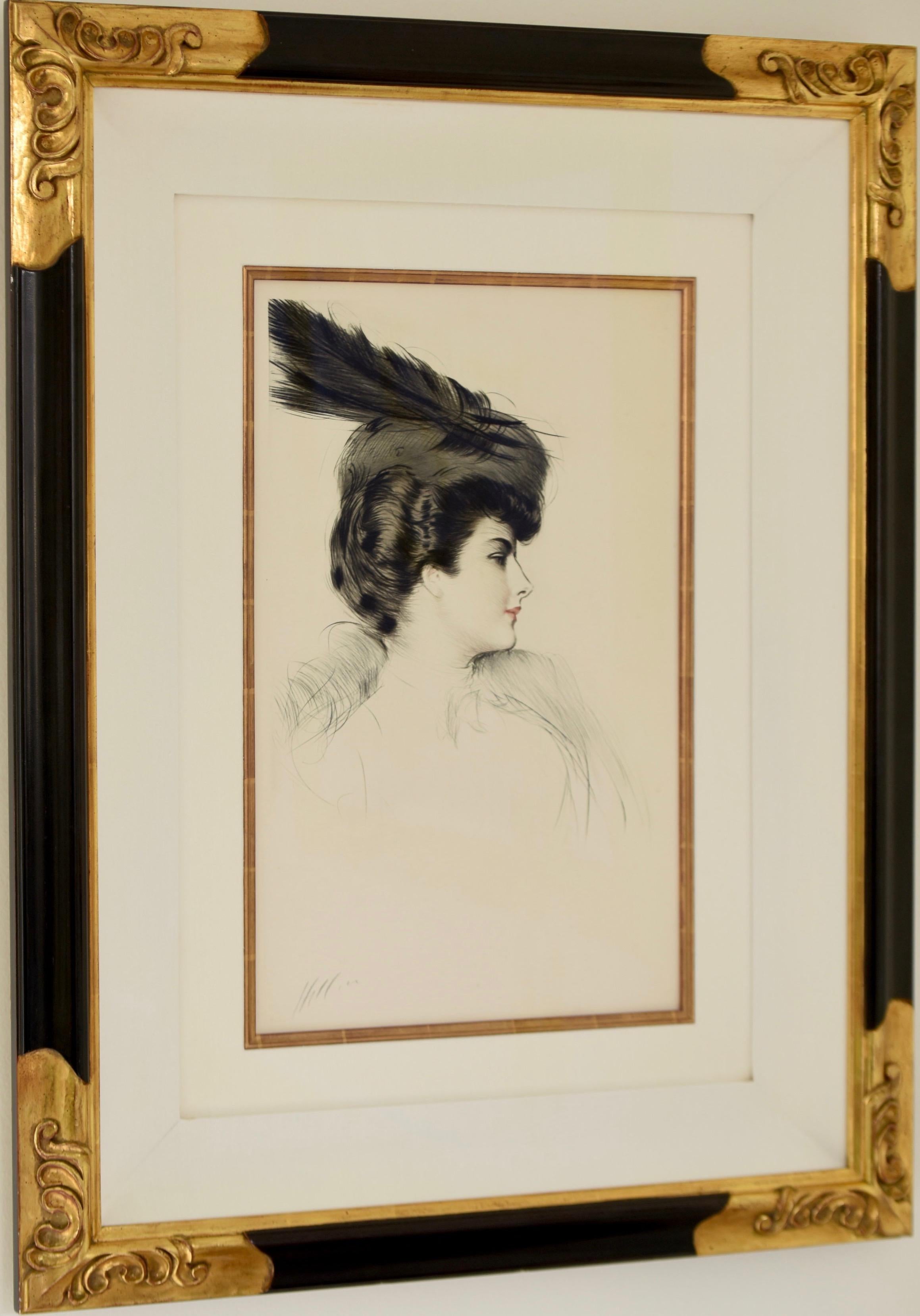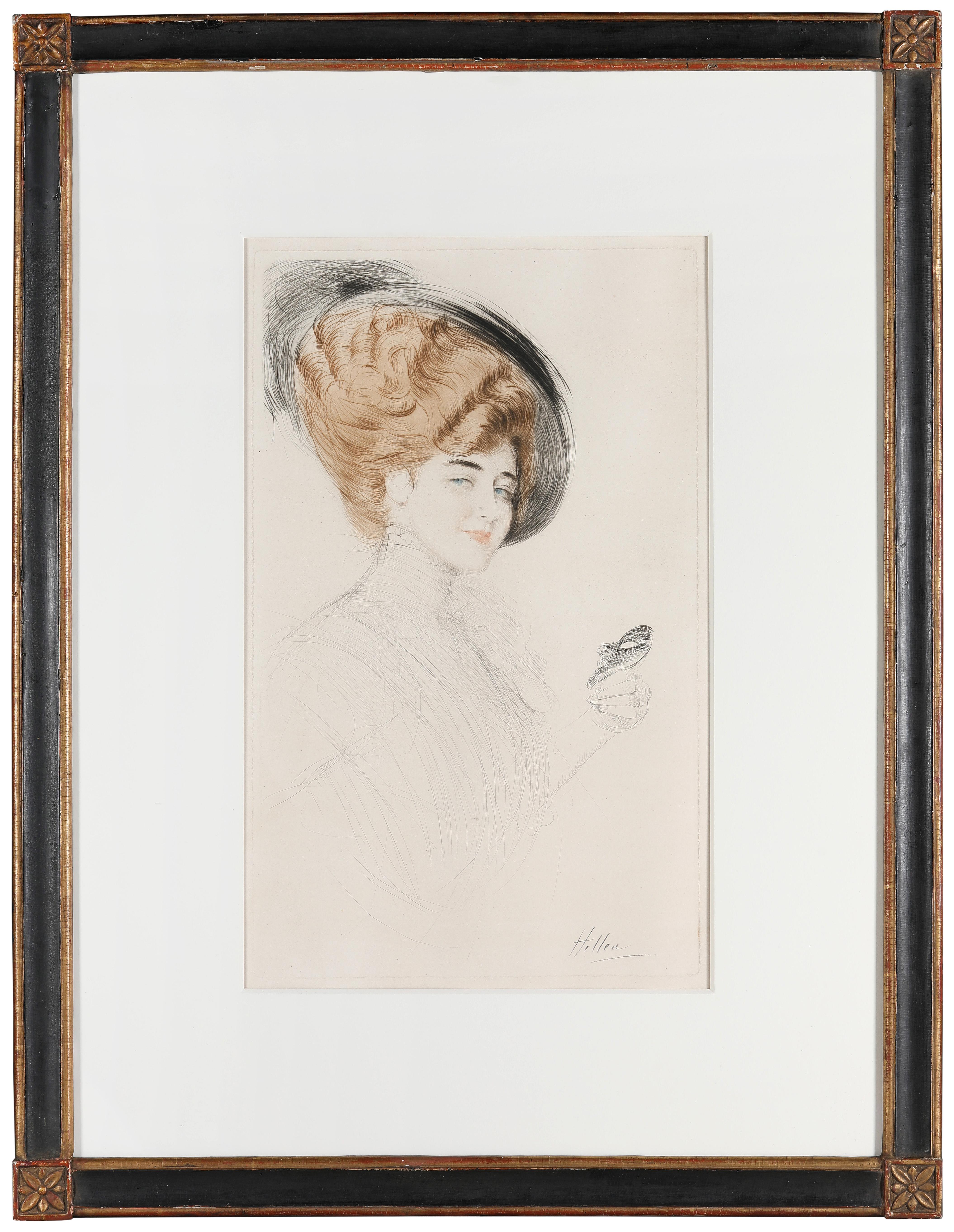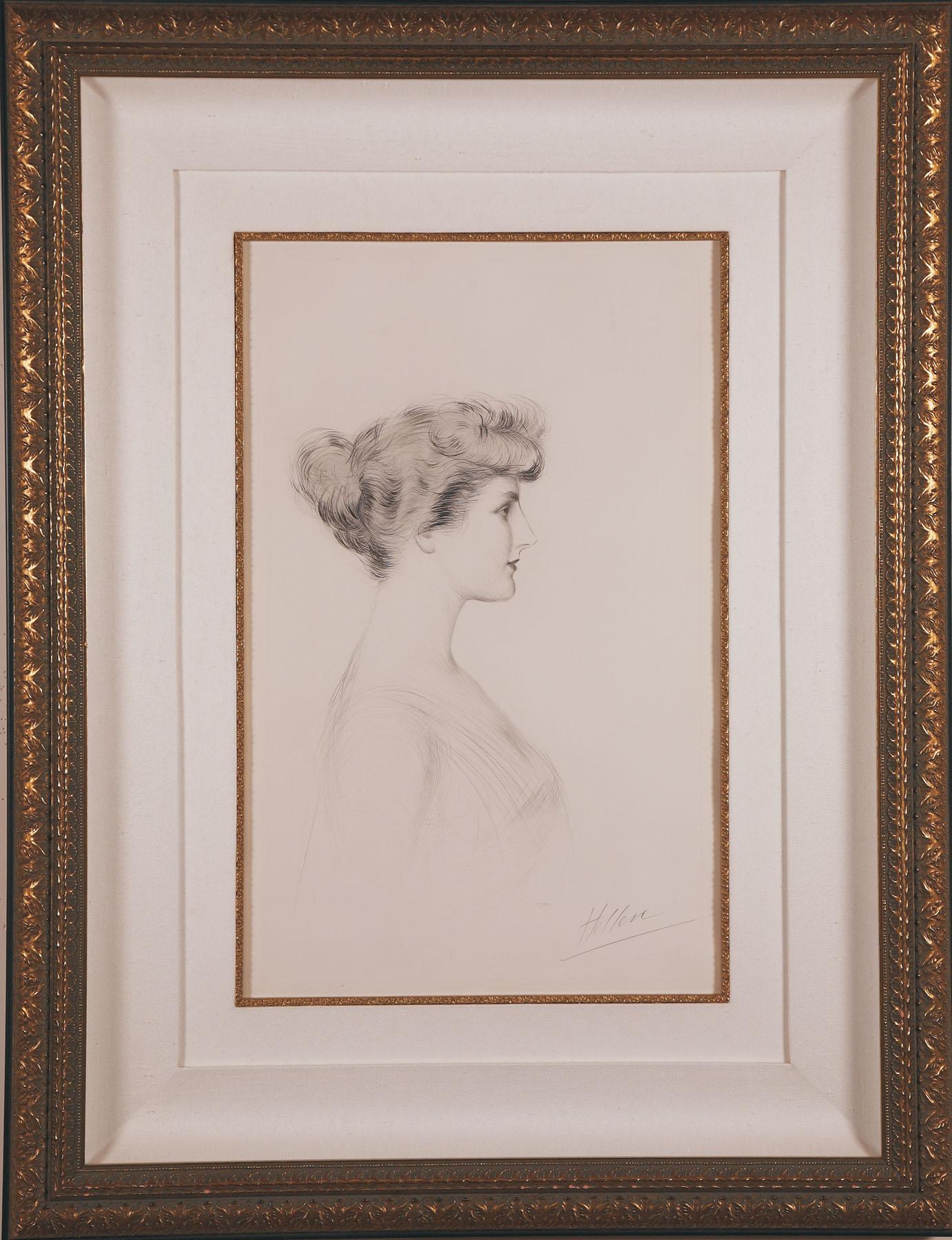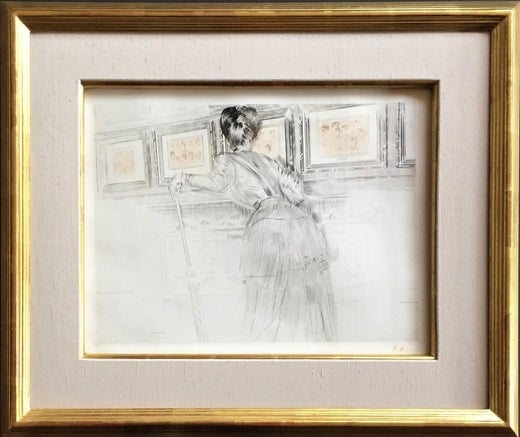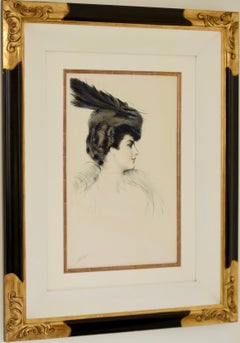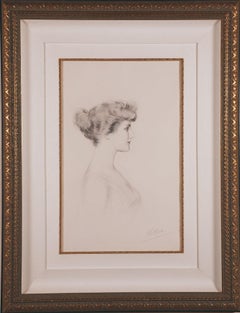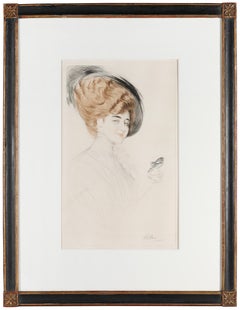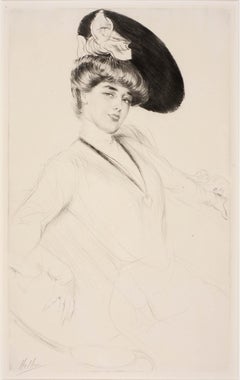Items Similar to "Dame a la Toque", fabulous drypoint etching by Paul Cesar Helleu
Want more images or videos?
Request additional images or videos from the seller
1 of 8
Paul César Helleu"Dame a la Toque", fabulous drypoint etching by Paul Cesar Helleu1906
1906
$35,000
£26,928.80
€30,772.94
CA$50,093.35
A$54,625.89
CHF 28,696.41
MX$654,724.11
NOK 363,898.67
SEK 338,641.99
DKK 229,839.99
About the Item
HELLEU, PAUL CÉSAR
(1859 - 1927)
"La Dame a la Toque"
(Lady in Fur Hat)
Montesquiou XXXVI, c. 1906
Drypoint printed in colors on pale cream wove paper
Signed in black crayon lower left Signed in pencil, lower left
Full Margins, Plate Size 21” x 13 1/4”
Rich impression with dramatic drypoint burr and tone no other artist epitomizes the whole atmosphere of elegance and hedonistic pleasure which pervaded Paris society at the first decade of the century as does Helleu. A close friend of Proust and the inspiration for one of the principal characters in La Recherche du Temps Perdu, Helleu’s whole life style echoed the incomparable elegance and flow of his drawing, the sheer style of his art, and his eye for the poses of the beautiful women who were his friends and his patrons. During the 1870’s, Helleu had come to know the painters of Impressionism and also artists Sargent and Whistler who became his special friends and inspiration. By the early 1880’s, he had already developed the quality of expressive sweeping line, which is the essence of his drawing, but in 1885 he was encouraged by Tissot to try working on prints in drypoint. At this time, Tissot had decided, after the death of his lover and model Kathleen Newton, to travel to the Holy Land on an artistic pilgrimage. Having decided he would no longer engrave, he gave Helleu his diamond stylus…a literal and figurative “passing of the baton”. It was in the incision and texture of drypoint that his art was to reach one of its greatest peaks. He had an innate feel for the balance between a lightly curving stroke and the deeply cut highly tonal burr of the strongest drypoint. Around the turn of the century he started to combine drypoint with multi-inking in colors, the areas of color restricted to such touches as the bows on the hats, the hair color or the red of the lips. The plate was drawn at a single sitting, and then the color inks were brushed onto it. The results are some of the most splendid and decorative of all Belle Époque prints.
- Creator:Paul César Helleu (1859-1927, French)
- Creation Year:1906
- Dimensions:Height: 37 in (93.98 cm)Width: 28.5 in (72.39 cm)Depth: 2 in (5.08 cm)
- More Editions & Sizes:Very RarePrice: $35,000
- Medium:
- Movement & Style:
- Period:
- Condition:This piece is in a custom finished corner frame with UV protective plexiglass.
- Gallery Location:Hinsdale, IL
- Reference Number:Seller: 17731stDibs: LU138429467832
Paul César Helleu
Rich impression with dramatic drypoint burr and tone no other artist epitomizes the whole atmosphere of elegance and hedonistic pleasure which pervaded Paris society at the first decade of the century as does Helleu. A close friend of Proust and the inspiration for one of the principal characters in La Recherche du Temps Perdu, Helleu’s whole life style echoed the incomparable elegance and flow of his drawing, the sheer style of his art, and his eye for the poses of the beautiful women who were his friends and his patrons. During the 1870’s, Helleu had come to know the painters of Impressionism and also artists Sargent and Whistler who became his special friends and inspiration. By the early 1880’s, he had already developed the quality of expressive sweeping line, which is the essence of his drawing, but in 1885 he was encouraged by Tissot to try working on prints in drypoint. At this time, Tissot had decided, after the death of his lover and model Kathleen Newton, to travel to the Holy Land on an artistic pilgrimage. Having decided he would no longer engrave, he gave Helleu his diamond stylus…a literal and figurative “passing of the baton”. It was in the incision and texture of drypoint that his art was to reach one of its greatest peaks. He had an innate feel for the balance between a lightly curving stroke and the deeply cut highly tonal burr of the strongest drypoint. Around the turn of the century he started to combine drypoint with multi-inking in colors, the areas of color restricted to such touches as the bows on the hats, the hair color or the red of the lips. The plate was drawn at a single sitting, and then the color inks were brushed onto it. The results are some of the most splendid and decorative of all Belle Époque prints.
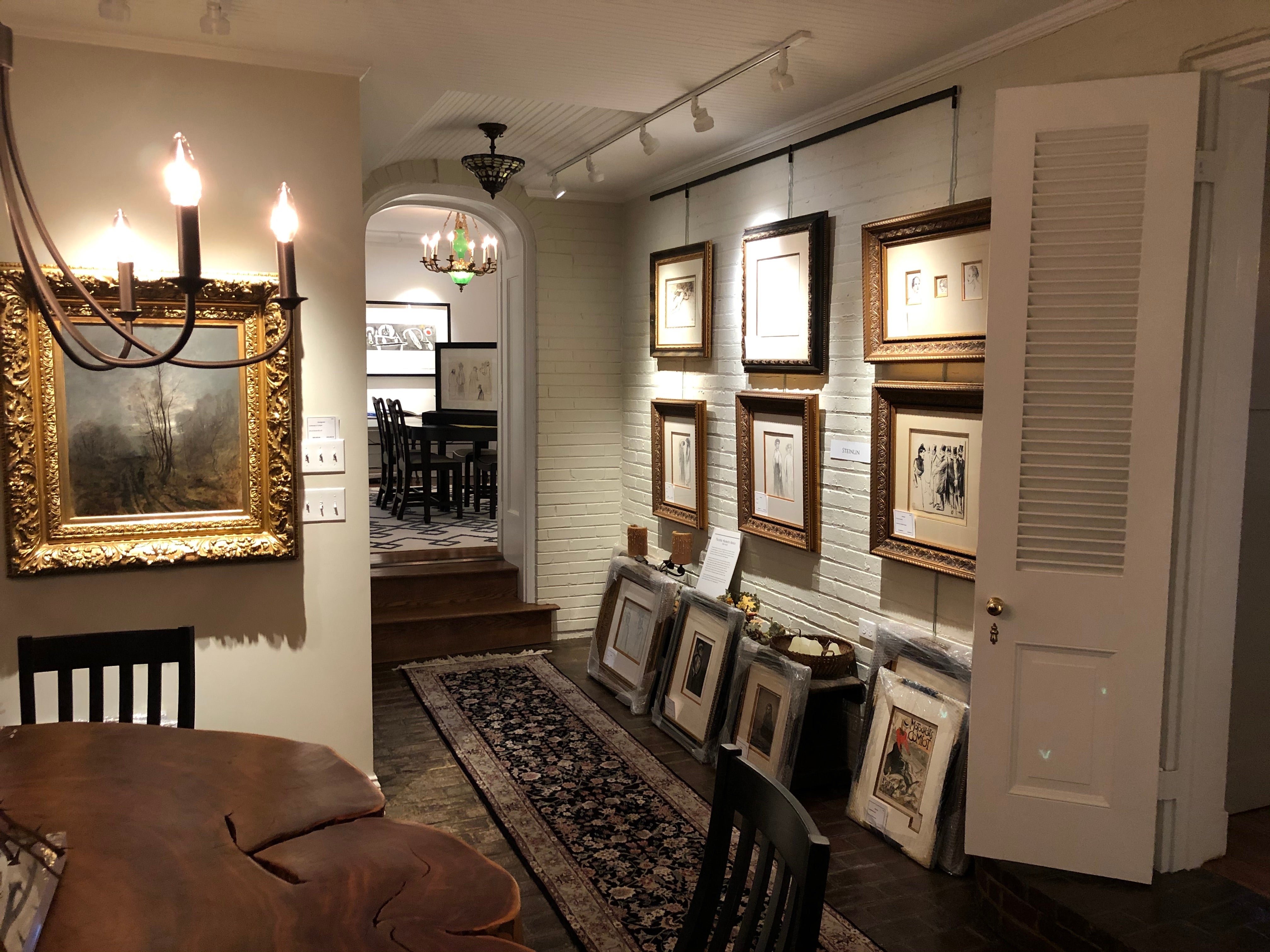
About the Seller
5.0
Recognized Seller
These prestigious sellers are industry leaders and represent the highest echelon for item quality and design.
Gold Seller
Premium sellers maintaining a 4.3+ rating and 24-hour response times
Established in 1994
1stDibs seller since 2020
47 sales on 1stDibs
Typical response time: 3 hours
- ShippingRetrieving quote...Shipping from: Hinsdale, IL
- Return Policy
More From This Seller
View All"Dame a la Toque", fabulous drypoint etching by Paul Cesar Helleu
By Paul César Helleu
Located in Hinsdale, IL
HELLEU, PAUL CÉSAR
(1859 - 1927)
"La Dame a la Toque"
(Lady in Fur Hat)
Montesquiou XXXVI, c. 1906
Drypoint printed in colors on pale cream wove paper
Signed in black crayon lower ...
Category
Early 20th Century Post-Impressionist Portrait Prints
Materials
Drypoint
"Dame a la Toque", fabulous drypoint etching by Paul Cesar Helleu
By Paul César Helleu
Located in Hinsdale, IL
HELLEU, PAUL CÉSAR
(1859 - 1927)
"La Dame a la Toque"
(Lady in Fur Hat)
Drypoint printed in colors on pale cream wove paper, c. 1906
Signed in black crayo...
Category
Early 20th Century Post-Impressionist Portrait Prints
Materials
Drypoint
"Madame Georges Menier" Portrait, by Paul Cesar Helleu
By Paul César Helleu
Located in Hinsdale, IL
HELLEU, PAUL CÉSAR
(1859 -1927)
"MADAME GEORGES MENIER"
Montesquiou XXI
Drypoint in colors, c. 1900
Signed in pencil, lower right
Printed on wove paper
Full...
Category
Early 20th Century Art Nouveau Portrait Prints
Materials
Drypoint
"Portrait of Madame Georges Menier" By Helleu
By Paul César Helleu
Located in Hinsdale, IL
HELLEU, PAUL CÉSAR
(1859 - 1927)
MADAME GEORGES MENIER
Montesquiou XXI
Drypoint in colors, c. 1900
Signed in pencil, lower right
Printed on wove paper
Full Margins
22 1/4” x 13...
Category
Early 19th Century Art Nouveau Figurative Prints
Materials
Drypoint, Etching
Original Drawing "Jeune Femme Assise" by Paul Cesar Helleu, c. 1910
By Paul César Helleu
Located in Hinsdale, IL
HELLEU, PAUL CÉSAR
(1859 -1927)
"JEUNE FEMME ASSISE"
(Young Woman Seated)
Original Drawing in sanguine, white and black chalks, c. 1910
Signed in pencil by artist, lower right
Full M...
Category
Early 20th Century Impressionist Figurative Drawings and Watercolors
Materials
Chalk, Carbon Pencil
Original Drawing "Jeune Femme Assise" by Paul Cesar Helleu, c. 1910
By Paul César Helleu
Located in Hinsdale, IL
HELLEU, PAUL CÉSAR
(1859 -1927)
"JEUNE FEMME ASSISE"
(Young Woman Seated)
Original Drawing in sanguine, white and black chalks, c. 1910
Signed in pencil by artist, lower right
Full Margins on cream wove paperImage size: 17.5” x 11.02”
Paul César Helleu...
Category
Early 20th Century Impressionist Figurative Drawings and Watercolors
Materials
Chalk
You May Also Like
Paul César Helleu "Le masque" Color Etching, Hand-Signed, Art Nouveau
By Paul César Helleu
Located in Eltville am Rhein, DE
Paul César Helleu
Vannes 1859 - 1927 Paris
"Le masque"
Color etching on handmade paper
Signed in pencil lower right
Image: 52.5 x 33 cm
Frame: 93 x 72 cm
Old 19th-century frame, acid...
Category
Early 1900s Art Nouveau Figurative Prints
Materials
Etching
Paul César Helleu "Study of Women" Etching, Hand-Signed, Art Nouveau
By Paul César Helleu
Located in Eltville am Rhein, DE
Paul César Helleu
Vannes 1859 - 1927 Paris
"Study of 4 women"
Etching on handmade paper
Signed in pencil lower left
Inscribed lower right with "Unique epreuve, ....."
Rare proof prin...
Category
Early 1900s Art Nouveau Figurative Prints
Materials
Etching
Miss Taylor
By Paul César Helleu
Located in Fairlawn, OH
Miss Taylor
Drypoint, c. 1900
Signed in pencil lower left (see photo)
Small edition, about 10
Very rich impression, full of burr
Condition: Excellent
Image size: 21-1/4 x 13-1/4"
She...
Category
Early 1900s Art Nouveau Portrait Prints
Materials
Drypoint
La Duchesse de Marlborough, Consuelo Vanderbilt
By Paul César Helleu
Located in Storrs, CT
Paul César Helleu. La Duchesse de Marlborough, Consuelo Vanderbilt. c. 1901. Drypoint. 21 1/2 x 13 3/4 (sheet 24 x 15). A rich impression printed o...
Category
Late 19th Century Impressionist Portrait Prints
Materials
Drypoint, Etching
$16,000 Sale Price
36% Off
Helleu, Watercolor Lithograph, Portrait of Mme Chéruit, Early 20th Century
By Paul César Helleu
Located in MARSEILLE, FR
Watercolor lithograph presenting the portrait of Madame Chéruit, by the artist Paul César Helleu
Madame Chéruit was one of the first women to run a fashion house in Paris at the beginning of the 20th century, Place Vendôme. Her taste and refinement were recognized internationally, and she dressed many clients, including our artist's wife, Paul-César Helleu; this one has represented Mme Chéruet on many occasions
Paul César Helleu (1859-1927) is a French painter and engraver; he entered the Ecole des Beaux-Arts in Paris in 1876, in the studio of Jean-Léon Gérôme, but more attracted by outdoor painting, he became the friend of Claude Monet, Giovanni Boldini, among others. From his very important career, we note his beginnings with the ceramist Theodore Deck, for whom he created decorations for dishes; his many portraits of Parisian High Society, elegant women; his exhibitions of non-standard paintings at the Salon des Artistes with Les Grandes Eaux du Bassin de Latone; the decoration of the starry vault...
Category
Early 20th Century French Art Nouveau Decorative Art
Materials
Paper
Portrait de femme en buste, de profil a gauche, un tres large ruban noir du cou
By Paul César Helleu
Located in Fairlawn, OH
Portrait de femme en buste, de profil a gauche, un tres large ruban noir du cou, Mme Marthe Letellier
Drypoint, 1900-1901
Signed in pencil lower left (see photo)
Titled in pencil low...
Category
Early 1900s Impressionist Figurative Prints
Materials
Drypoint
More Ways To Browse
Madison Avenue Art
Mail Coach
Master Of Hounds
Mexican Woman Painting
Milkmaid Painting
Mushroom Watercolor
Native American Pop
Occult Art
Oil Paintings Czech
Oliver Messel
Painting By Ritter
Paris Street Scene Watercolor
Peter Max Love
Physique Pictorial
Portrait Sultan
Racehorse Oil
Red Devil Vintage
Sensual Couple
